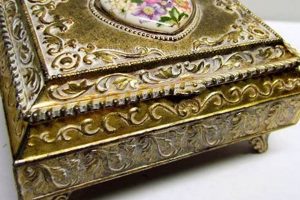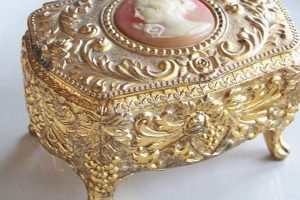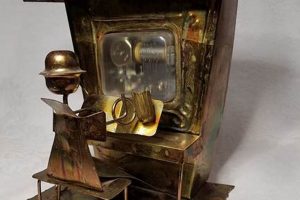A mechanical instrument from a prior era that produces musical tones. These items typically feature a rotating cylinder or disc with pins that pluck the tuned teeth of a comb or lamellae, generating melodies. An exemplar is a Swiss-made Reuge, known for its intricate marquetry and complex movements.
These artifacts represent both technological ingenuity and artistic craftsmanship, providing insights into past social customs and aesthetic preferences. Their preservation is culturally significant, allowing future generations to appreciate the history of automated musical devices and the evolution of music technology. The intricate mechanisms often reflect the socio-economic status of their original owners, as well as technological advancements over time.
The following sections will delve into the collecting, restoration, and valuation of these historical instruments, offering practical guidance for enthusiasts and those interested in preserving these tangible pieces of history.
Guidance on Acquiring and Maintaining Mechanical Musical Instruments
The acquisition and preservation of mechanical musical instruments require careful consideration and informed decisions. The following guidelines aim to assist individuals in navigating this specialized field.
Tip 1: Research Provenance. Prior to acquiring, meticulously investigate the items history. Documentation, labels, and makers marks can provide crucial information regarding its authenticity, origin, and past ownership.
Tip 2: Assess Mechanical Condition. Thoroughly evaluate the functionality of the movement. Note any signs of wear, damage, or previous repairs. Irregularities in sound or movement can indicate underlying mechanical issues requiring professional attention.
Tip 3: Scrutinize the Case and Finish. Examine the external casing for structural integrity and original finish. Damage to the case can affect the value and overall condition of the piece. Look for signs of improper restoration or alteration.
Tip 4: Consult with Experts. Seek advice from specialists in antique mechanical instruments. Their expertise can provide valuable insights into valuation, restoration options, and potential risks associated with specific pieces.
Tip 5: Prioritize Conservation. Employ appropriate conservation techniques to safeguard against deterioration. Control environmental factors such as humidity and temperature to minimize damage to delicate components.
Tip 6: Document Existing Condition. Create a detailed record of the item’s state at the time of acquisition, including photographs and written descriptions. This documentation is invaluable for insurance purposes and future restoration efforts.
Tip 7: Inquire about Replacement Parts Availability. Research the feasibility of obtaining replacement parts should repairs become necessary. The availability of original or compatible components can significantly impact long-term maintenance.
These guidelines offer a foundation for informed decision-making in the realm of mechanical musical instruments. Diligence and expert consultation are essential for responsible acquisition and long-term preservation.
The following sections will address specific aspects of mechanical instrument restoration and valuation in greater detail.
1. Mechanism
The internal workings are fundamental to its identity, serving as the engine of musical production and a testament to historical engineering. An understanding of these intricate systems is crucial for evaluating condition, determining value, and appreciating the ingenuity of its creators.
- Cylinder/Disc
This component acts as the music program, encoding melodies via precisely placed pins or projections. The arrangement of these features directly dictates the musical sequence, offering a tangible representation of compositional intent. A damaged or altered cylinder/disc compromises the instrument’s ability to accurately reproduce its intended musical selection.
- Comb/Lamellae
The tuned metal teeth, or lamellae, vibrate to produce distinct musical notes when engaged by the cylinder’s pins. The precision of their tuning and the integrity of their physical structure are paramount to the instrument’s tonal quality. Broken or detuned lamellae necessitate specialized repair to restore the instrument’s original sound.
- Drive System
This element, typically consisting of a spring-powered motor and governor, provides the energy to rotate the cylinder or disc at a consistent speed. The drive system’s efficiency and reliability directly impact the instrument’s ability to maintain accurate tempo and duration. Malfunctions within the drive system are common issues in aged examples, requiring careful restoration.
- Dampers
These components serve to mute the lamellae after being struck, preventing unwanted resonance and ensuring clear articulation. Their presence and functionality contribute significantly to the instrument’s overall sound quality and fidelity. Deteriorated or missing dampers can result in a muddied or indistinct sound.
In essence, the mechanical integrity of these key components determines the musical instrument’s functionality and value. Each element plays a distinct role, and their combined performance dictates the quality and accuracy of the music produced. Attention to these details is essential when assessing the condition, restorability, and overall worth of a musical artifact.
2. Aesthetics
The visual appeal is integral to its perceived value and cultural significance. Beyond its function as a musical device, the external presentation contributes substantially to its desirability as a collectible item and a decorative object reflecting a specific era’s artistic sensibilities.
- Cabinetry and Materials
The outer casing, often crafted from fine hardwoods such as rosewood, walnut, or mahogany, determines the overall aesthetic impression. Inlay work, marquetry, and carving enhance the visual complexity and reflect the craftsmanship involved. The quality of the materials and the intricacy of the cabinet design are indicators of the original owner’s affluence and the object’s intended purpose as a status symbol.
- Surface Finish and Ornamentation
The applied finish, whether varnish, lacquer, or shellac, impacts the visual depth and luster of the wood. Ornamental details, such as gilt accents, brass fittings, and painted scenes, add visual interest and align with prevailing artistic trends. The preservation of the original finish and ornamentation is crucial to maintaining the object’s historical integrity and aesthetic value.
- Decorative Motifs
The thematic elements incorporated into the design, such as floral patterns, pastoral scenes, or mythological figures, provide insights into the cultural context and artistic preferences of the period. These motifs often reflect prevailing artistic movements, such as Art Nouveau or Art Deco, and contribute to the object’s overall visual narrative. The selection and execution of these motifs significantly impact the object’s aesthetic appeal and collectibility.
- Form and Proportion
The overall shape and dimensions contribute to its visual harmony and presence within a given space. The balance between horizontal and vertical elements, as well as the relationship between the case and the internal mechanism, are critical to its aesthetic success. Proportions that adhere to classical design principles tend to be more aesthetically pleasing and enhance the object’s perceived value.
The aesthetic dimensions, therefore, are not merely superficial but are intrinsically linked to its historical context and artistic merit. Careful evaluation of these factors is essential for assessing its overall value and appreciating its contribution to the decorative arts.
3. Rarity
The scarcity of a particular model directly influences its desirability and value within the collecting community. Infrequent production runs, limited edition releases, or unique features contribute to heightened demand and, consequently, elevated market prices. A cause-and-effect relationship exists between limited availability and increased collector interest. For example, a model produced for a specific royal occasion, with a limited run of only a few examples, commands a premium due to its historical association and extreme scarcity. The importance of rarity stems from its direct impact on perceived value and its role in distinguishing one piece from another.
Several factors contribute to rarity. Limited production, as mentioned, is a primary driver. However, the survival rate of specific models plays a significant role. Instruments subjected to frequent use or improper storage are less likely to endure, further reducing their numbers over time. Geographic distribution also influences rarity; examples originally intended for specific markets may be scarce in other regions, increasing their appeal to international collectors. Understanding the interplay of these factors is essential for informed acquisition decisions and accurate valuation.
Ultimately, the understanding of rarity is paramount in the collecting of historical musical artifacts. It informs investment strategies, guides restoration priorities, and enhances the appreciation of these instruments as unique historical artifacts. While rarity alone does not guarantee value, its consideration alongside other factors, such as condition and provenance, provides a comprehensive framework for assessing the worth and significance of mechanical musical instruments.
4. Condition
The state of preservation is a fundamental determinant of value and desirability. It encompasses both the mechanical functionality and the aesthetic appearance, reflecting the instrument’s history of use, storage, and maintenance. A carefully preserved piece commands a premium, while extensive damage or deterioration significantly reduces its worth.
- Mechanical Functionality
The operational state of the movement directly impacts the instrument’s ability to produce music accurately. Issues such as sluggish operation, skipping notes, or a broken mainspring detract from its value. A non-functional item necessitates costly repairs, impacting its appeal to collectors seeking immediate playability. Restored mechanical functionality increases value by enabling the full auditory experience as originally intended.
- Case and Finish Integrity
The external casing and its finish contribute significantly to the overall aesthetic appeal. Scratches, dents, or fading diminish the visual impression, particularly if the original finish is compromised. Damage to inlay work or marquetry further detracts from the aesthetic value. A well-preserved or expertly restored case enhances the object’s perceived quality and contributes to its collectibility.
- Component Originality
The presence of original components, such as the comb, cylinder, or dampers, is highly valued by collectors. Replacement parts, especially if non-original, reduce the item’s authenticity and historical significance. A completely original piece, even with some wear, is generally more desirable than one with numerous replaced components, regardless of their quality.
- Evidence of Past Repairs
Previous repair attempts, particularly if poorly executed, can negatively impact value. Visible glue marks, mismatched components, or evidence of amateur craftsmanship detract from the overall presentation. Professional restoration, while improving functionality and appearance, can also influence value depending on the skill and expertise of the restorer, and the goal in restoration whether preservation of originality is the goal versus complete renewal.
In conclusion, the state of preservation intertwines mechanical performance, aesthetic presentation, and historical integrity. Evaluating these facets collectively allows for a comprehensive assessment of its condition, directly influencing its worth and appeal to collectors. It is important to consider preservation efforts and restoration when determining the condition of the vintage music box.
5. Provenance
Provenance, the documented history of ownership for a specific artifact, holds significant weight in the valuation and authentication process. Its verifiable trajectory from creation to present ownership enhances its desirability and contributes to its historical narrative. Without verifiable origin, authenticity is difficult to prove, thereby lowering the inherent financial and cultural worth.
- Chain of Ownership
A clear and unbroken record of past owners establishes the chain of custody, providing assurance against potential forgery or misrepresentation. Documentation, such as bills of sale, letters of correspondence, and estate inventories, serves as evidence linking the artifact to its previous possessors. For example, a music box with traceable ownership back to a known historical figure or notable collection significantly increases its value and appeal.
- Historical Context
Provenance situates the item within a specific historical timeframe and social context. Information about its past owners and the environments in which it resided provides insights into its cultural relevance and significance. A music box used in a particular historical event, such as a royal coronation or a significant social gathering, gains additional historical importance and collectibility.
- Authentication Support
A well-documented history aids in verifying its authenticity and confirming its origins. Expert appraisals and scientific analysis can corroborate the provenance record, providing further assurance to potential buyers. Makers’ marks, serial numbers, and documented repairs contribute to the overall authentication process, ensuring the instrument’s legitimacy and preventing fraudulent claims.
- Impact on Value
Strong provenance positively influences the instrument’s monetary worth. Collectors are willing to pay a premium for artifacts with a clear and verifiable history, particularly if that history connects the item to notable individuals or historical events. The presence of complete documentation, including original invoices, service records, and family histories, significantly enhances its market value.
In sum, provenance is a critical factor in establishing the authenticity, historical context, and value of a musical artifact. A comprehensive and verifiable history elevates its status from a mere mechanical instrument to a tangible piece of cultural heritage, enriching its narrative and solidifying its appeal to collectors and enthusiasts alike. This rigorous verification process is crucial for sustaining the integrity of the market and protecting the historical significance of these tangible artifacts.
6. Restorability
Restorability significantly influences the valuation and preservation efforts associated with vintage mechanical musical instruments. The feasibility of returning a damaged or deteriorated item to its original functionality and aesthetic appearance is a critical factor for collectors and conservators. The cause of damage, the availability of replacement parts, and the skill required for proper restoration all contribute to the overall restorability assessment. An instrument deemed easily restorable commands a higher market price due to its potential to regain its former glory. Conversely, extensive, irreparable damage diminishes its value, relegating it to a source of spare parts rather than a fully functional artifact. The type and extent of deterioration greatly influence the work. For example, a broken mainspring may be easily replaced, while a cracked cylinder or missing comb teeth pose far greater restoration challenges.
The practicality of understanding restorability extends to informed acquisition decisions. Potential buyers must evaluate the costs associated with bringing an instrument back to its optimal state. This involves assessing the extent of damage, identifying qualified restorers, and sourcing necessary components. Professional restoration is often labor-intensive and requires specialized knowledge of horology, woodworking, and metallurgy. Understanding restorability aids in differentiating between a worthwhile investment and a potential money pit. Furthermore, restorability considerations guide conservation strategies. Preventing further deterioration through proper storage and handling is often preferable to attempting complex and costly repairs. Climate control and the use of appropriate cleaning agents can extend the lifespan of an instrument, reducing the need for invasive restoration procedures.
In conclusion, restorability serves as a crucial filter for assessing the long-term viability and value of these historical mechanical objects. Its evaluation involves a comprehensive understanding of mechanical principles, material science, and conservation ethics. The challenge lies in balancing the desire for authentic restoration with the practical constraints of cost, skill, and the availability of original components. Prioritizing preventive conservation and making informed restoration decisions are key to preserving these tangible elements of musical history for future generations.
Frequently Asked Questions
The following section addresses common inquiries regarding historical mechanical musical instruments, providing factual answers to frequently encountered questions.
Question 1: What factors determine the monetary value of a historical mechanical musical instrument?
The instruments market value is contingent upon several interrelated variables, including its mechanical condition, aesthetic appeal, rarity, documented history, and restorability. Mechanical functionality and visual presentation are critical, with well-preserved and fully operational models commanding higher prices. Scarcity and a verifiable provenance further augment its desirability and, thus, its market value.
Question 2: How can one ascertain the authenticity of a purported historical mechanical musical instrument?
Authentication necessitates meticulous examination of various elements. Makers’ marks, serial numbers, and stylistic characteristics consistent with the purported period of origin are crucial indicators. Expert appraisal, coupled with scientific analysis of materials and construction techniques, can further validate the authenticity and provenance of the instrument.
Question 3: What are the optimal environmental conditions for preserving historical mechanical musical instruments?
Maintaining stable environmental conditions is essential for long-term preservation. Fluctuations in temperature and humidity can cause damage to wooden components, metal parts, and delicate finishes. Storing the instrument in a climate-controlled environment, with relative humidity levels between 45% and 55% and a consistent temperature, minimizes the risk of deterioration.
Question 4: What are common mechanical issues encountered in historical mechanical musical instruments?
Typical mechanical problems include broken mainsprings, worn gears, detuned comb teeth, and malfunctioning governors. These issues often stem from age, use, and lack of proper maintenance. Professional repair by a qualified horologist or mechanical instrument specialist is typically required to address such complications effectively.
Question 5: Is it advisable to attempt self-repair on a historical mechanical musical instrument?
Amateur repair attempts are generally discouraged, as they can potentially exacerbate existing damage or cause irreversible harm to delicate components. Proper restoration necessitates specialized tools, technical expertise, and a thorough understanding of historical construction methods. Professional assistance from a qualified restorer is recommended to ensure its preservation.
Question 6: What considerations should be made when acquiring a historical mechanical musical instrument for investment purposes?
Acquiring for investment requires careful due diligence and market analysis. Researching historical sales data, consulting with expert appraisers, and assessing the instrument’s condition and provenance are critical steps. Focusing on rare, well-preserved examples with documented histories enhances the likelihood of long-term appreciation.
These responses provide fundamental insights into the world of mechanical musical instruments. Diligent research and expert consultation remain paramount for informed decision-making.
The following sections will delve into practical restoration techniques, further elucidating the nuances of preserving these important artifacts.
Conclusion
The preceding exploration has detailed essential considerations regarding the acquisition, preservation, and valuation of the mechanical musical instrument, often identified as a vintage music box. Key attributes such as the mechanism’s integrity, aesthetic presentation, relative rarity, physical condition, documented history, and restoration potential have been addressed. These elements collectively influence its perceived worth and cultural significance.
Continued scholarship and conscientious stewardship remain paramount to ensure the survival of these intricate artifacts. Further study and preservation efforts will sustain the appreciation of their historical value and mechanical ingenuity, allowing future generations access to these tangible remnants of a bygone era. The active engagement with these artifacts ensures their place within the broader cultural heritage.







